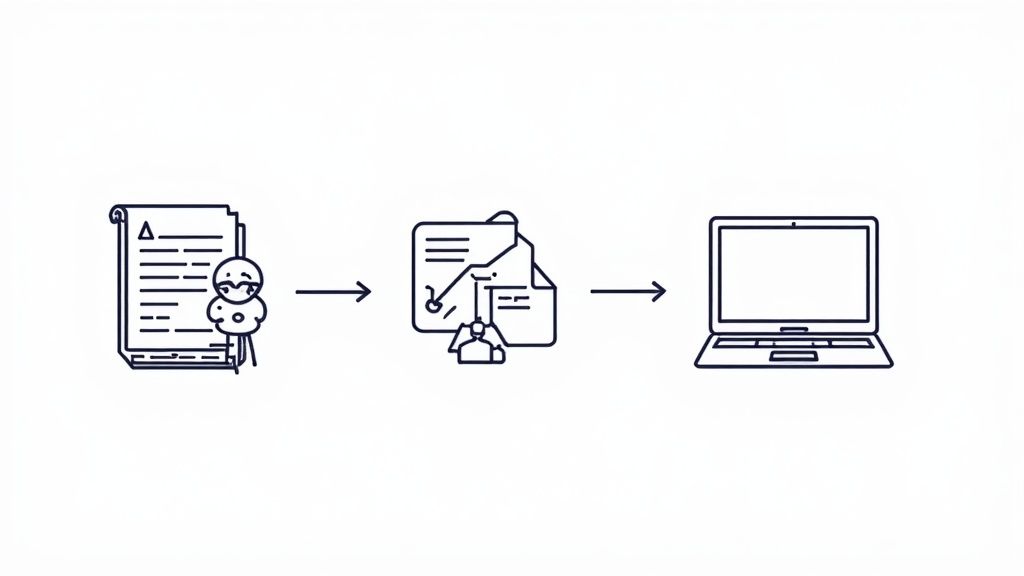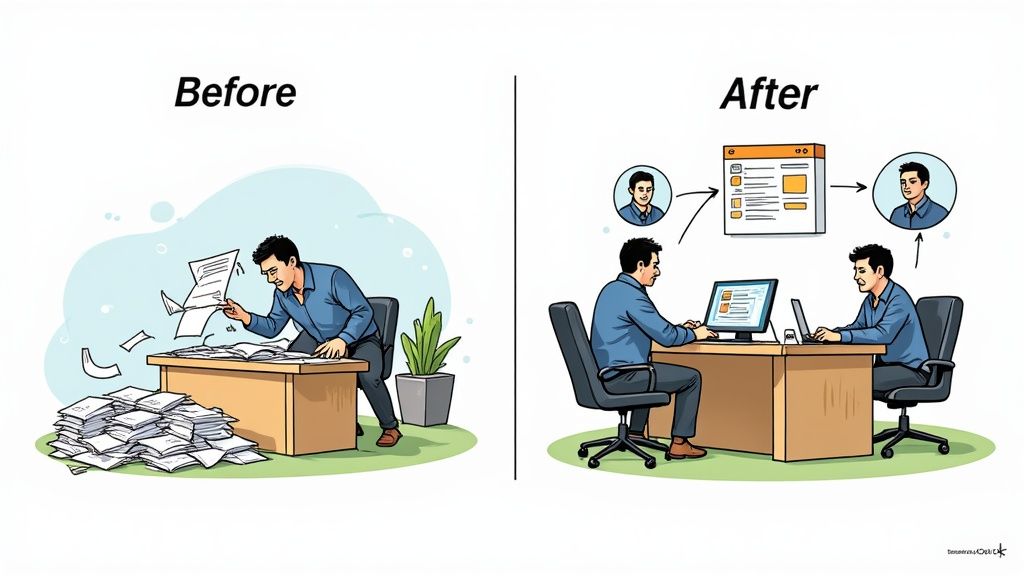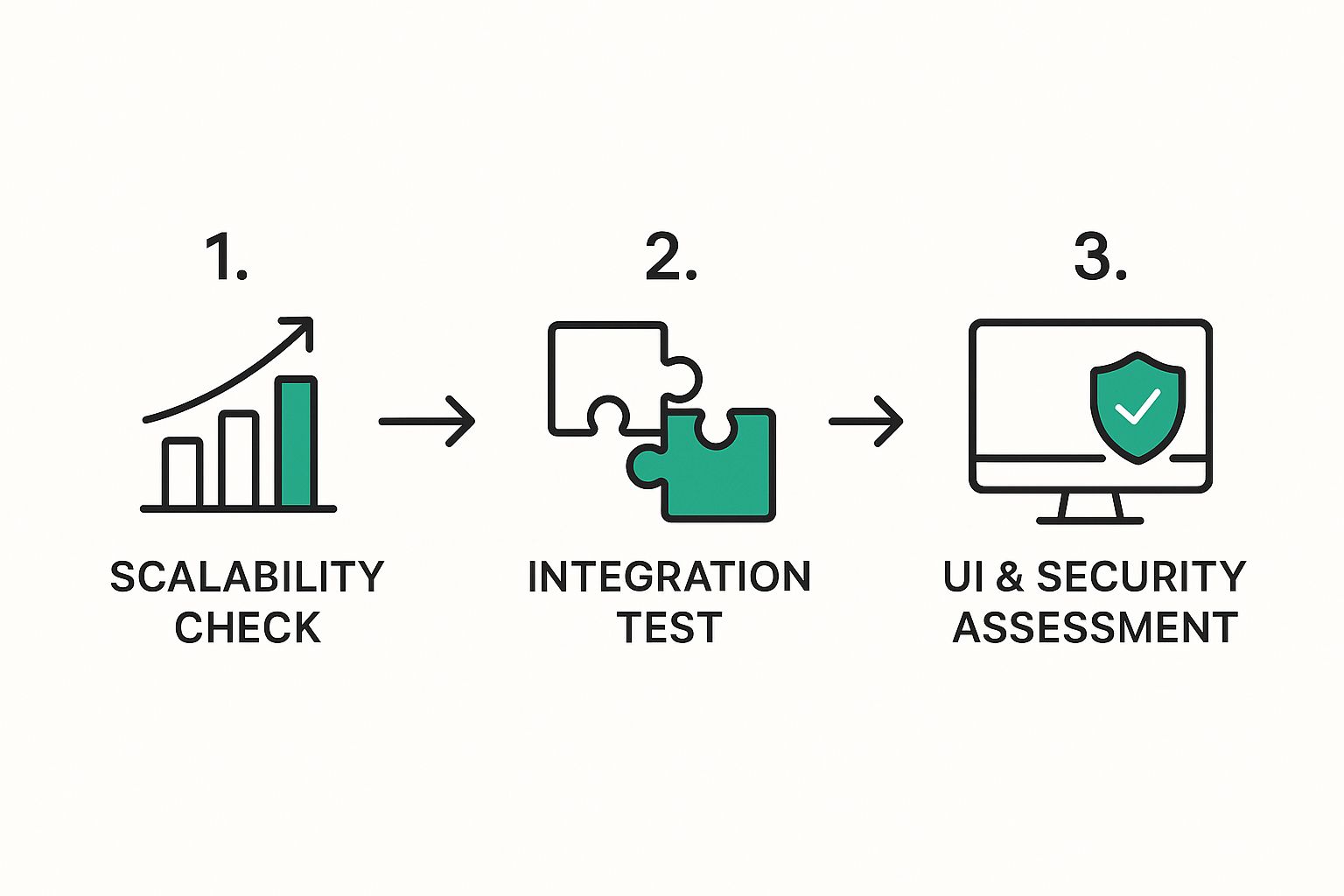
Best Employee Leave Management Software for Seamless Tracking
Posted by Robin on 17 Oct, 2025 in
At its core, employee leave management software is a digital tool designed to automate and centralise the entire journey of employee time off. From the initial request and approval right through to tracking balances, it takes the chaos of spreadsheets and manual admin and replaces it with a single, reliable system. The result?Everyone, from HR to individual team members, gets a crystal-clear view of leave schedules.
Moving Beyond Spreadsheets and Emails

Trying to run air traffic control with sticky notes and phone calls sounds absurd, right? It would be chaotic, inefficient, and riddled with risk. Yet, that's exactly what many businesses are doing when they manage employee leave with a patchwork of spreadsheets, email chains, and paper forms. This manual approach isn't just clumsy; it's a huge drain on time and a breeding ground for expensive mistakes.
An out-of-date spreadsheet might show someone has holiday days left when they’ve already used them up. A manager could easily miss a crucial email request, leaving their team short-staffed during a vital project. These seemingly small hiccups have a habit of snowballing into much bigger problems, hitting everything from payroll accuracy and team morale to your overall operational stability. The whole process becomes a disjointed puzzle where nobody has the full picture.
The Shift to a Centralised System
This is where employee leave management software steps in, acting like that modern air traffic control system for your team's time off. Instead of fragmented data scattered across different inboxes and files, it creates one single source of truth.
This technology transforms the messy, error-prone process of handling leave requests into a dependable, automated workflow. It provides a central hub where all leave-related activities are managed transparently and efficiently.
By ditching the manual methods, businesses see immediate benefits that go far beyond simple convenience. It’s about fundamentally changing how time off is viewed and managed within the organisation.
Unlocking Visibility and Fairness
One of the biggest wins from using dedicated software is the incredible visibility it offers. Managers can see team availability at a glance, helping them sidestep scheduling clashes and ensure there's always enough cover. Employees can check their own leave balances in real-time without having to bother HR, empowering them to plan their time off with total confidence.
This level of transparency also builds a culture of fairness. When you have clear, automated rules governing your leave policies, good things happen:
- Consistent Application: Policies are applied uniformly to everyone, which gets rid of the risk of accidental bias or inconsistent decisions.
- Clear Audit Trails: Every single request, approval, and adjustment is logged, creating an undeniable record for compliance purposes or if a dispute ever arises.
- Empowered Employees: Staff can pop their requests into a simple self-service portal, track the status, and get instant notifications.
Ultimately, bringing in employee leave management software isn't just a tech upgrade; it's an investment in running a better, smarter business. It swaps administrative bottlenecks for smooth processes, freeing up valuable time for HR to focus on more strategic work. Making the move from manual chaos to automated clarity ensures that managing time off supports the business instead of disrupting it—creating a better experience for everyone.
What Are the Essential Features of Leave Management Software?

Let's be honest, not all leave management platforms are created equal. Many promise to make time off simple, but the truly effective ones are packed with specific features built to handle the real-world headaches of UK businesses. These aren’t just bullet points on a sales page; they’re the tools that turn a chaotic, paper-shuffling process into something genuinely useful.
Think of it as the difference between a simple calculator and a powerful financial modelling tool. Both can do basic sums, but only one gives you the deep functionality to make smart, forward-thinking decisions. The right software features bring that level of control and insight to your HR team, making sure everything from payroll to team scheduling just works.
It's no surprise that the global market for this software has swelled to over USD 1.13 billion. UK companies, in particular, are moving away from spreadsheets, especially with flexible working now the norm. Good software is essential for tracking leave and staying on the right side of UK laws like the Working Time Regulations.
So, what should you actually look for? A good system is more than just a shared calendar. It’s a combination of smart automation, employee empowerment, and customisation that fits your unique business needs.
Let's break down the essential features you should expect from any leave management software worth its salt and see how they directly help UK businesses navigate the complexities of employee time off.
Essential Features of Leave Management Software
| Feature | Description | Benefit for UK Businesses |
|---|---|---|
| Automated Leave Tracking & Accruals | Automatically calculates and updates leave balances in real-time based on your policies (e.g., annual allowance, TOIL). | Eliminates manual calculation errors, preventing over or underpayment of holiday pay and ensuring accruals are always accurate. |
| Employee Self-Service Portal | A dashboard where employees can view their leave balance, see team availability, and submit time-off requests online. | Massively reduces HR admin time spent answering simple queries and gives employees autonomy over their leave planning. |
| Customisable Leave Policies | The ability to create and configure different rules for various leave types (holiday, sickness, parental leave, etc.). | Crucial for UK compliance. Allows you to set up rules for Statutory Sick Pay (SSP), carry-over limits, and other specific UK regulations. |
| Multi-Level Approval Workflows | Lets you design approval chains that automatically route requests to the correct manager or department head for sign-off. | Prevents bottlenecks and ensures requests are handled promptly, even if the primary approver is away. Reflects your real company structure. |
| Shared Team Calendar | A central, visual calendar showing who is off and when, often with filters for teams or departments. | Provides instant visibility for managers and team members, preventing scheduling clashes and making resource planning straightforward. |
| Reporting & Analytics | Tools to generate reports on absence trends, leave balances, and other key metrics, like the Bradford Factor. | Helps you spot patterns in absenteeism, plan for seasonal peaks, and make data-driven decisions about staffing and employee wellbeing. |
These features work together to create a system that’s not just about tracking time off, but about managing your workforce more effectively. They provide the structure needed to handle leave fairly, transparently, and in full compliance with UK law.
Automated Leave Tracking and Accruals
At the very core, any good system must automatically track who is off, when, and why. Relying on spreadsheets or paper forms is just asking for trouble—human error can creep in, leading to payroll mistakes or accidental policy breaches. Automation puts a stop to that by creating a single, reliable record of all absences.
This feature also handles the often-tricky maths of leave accrual. Whether your team earns holiday based on hours worked, a fixed annual allowance, or custom rules, the software does the hard work for you. This ensures every employee’s balance is spot-on, preventing awkward situations where someone takes more leave than they’ve actually earned.
Employee Self-Service Portal
One of the quickest ways to cut down on HR admin is to empower your team. A self-service portal gives employees a simple dashboard to manage their own time off, meaning they don’t have to email or call HR for every little thing. It’s a simple change, but the impact is huge.
Through the portal, your team can:
- Check Balances Instantly: See their remaining holiday, sick leave, and other allowances in real-time.
- Submit Requests Online: Fill out a simple form to request leave, often with a calendar view to check who else is off.
- Track Request Status: Know immediately if their request is pending, approved, or rejected, which removes any uncertainty.
This sense of ownership frees up your HR professionals from repetitive questions, letting them focus on bigger, more strategic work.
Customisable Leave Policies
The UK has its own unique and often complex set of leave regulations, from statutory sick pay (SSP) to shared parental leave. A generic, one-size-fits-all system just won't cut it. Your leave management software must have a flexible policy engine that you can shape to match your company's rules and legal duties.
This level of customisation is absolutely essential for UK compliance. It ensures your system correctly handles different leave types, waiting days for sickness, and specific accrual rules, shielding your business from legal risk. For a deeper dive, check out the benefits of fully customisable leave tracking.
Multi-Level Approval Workflows
In most businesses, a leave request doesn't just go to one person. It might need a nod from a line manager first, then a department head. A robust system lets you build multi-level approval workflows that mirror your company’s actual structure.
This means you can set up rules to automatically send requests to the right person for sign-off. Better still, if the main approver is on holiday themselves, the request can be escalated to someone else. This stops requests from getting stuck in limbo and makes sure employees get a response in good time. It’s all about making the approval process as smooth as your internal hierarchy.
The Real-World Benefits of Automated Leave Tracking

Bringing in new tech isn't about collecting tools; it's about getting real, tangible results. When you ditch a clunky spreadsheet for a dedicated employee leave management software, you see a fundamental shift in how your business runs. The positive effects ripple out, touching everyone from finance and HR right down to individual team members.
Think about a typical UK business before making the switch. The HR manager is drowning in paperwork, spending hours manually cross-referencing leave balances, chasing up line managers for approvals, and fielding the same questions about holiday entitlement over and over again. Payroll mistakes creep in, causing headaches and frustration.
Now, picture that same business after. Those tedious jobs are automated. HR is freed up to work on things that really matter, like employee development and making the company a better place to work.
This change really shines in three key areas, showing a clear and compelling return on your investment.
Boosting Operational Efficiency
The first thing you’ll notice is how much administrative grind the software eliminates. Manual processes are slow, repetitive, and a constant drag on productivity. A proper system automates these chores, creating a much slicker workflow.
Here’s what that looks like in practice:
- Reduced Admin Time: Tasks that used to eat up hours—like calculating pro-rata leave or spotting scheduling clashes—now happen in an instant.
- Faster Approvals: Managers get a notification and can approve or deny a request with a click. No more bottlenecks or delays.
- Self-Service Empowerment: Employees can check their own balances and book time off without having to ask HR, cutting down queries and giving them more autonomy.
By slashing the time spent on low-value admin, HR teams can finally focus on the high-impact work that actually moves the business forward. This operational lift is one of the most significant benefits for SMEs.
For a deeper dive into how this impacts smaller businesses, check out these three key benefits of absence management software for SMEs.
Achieving Clear Financial Gains
Beyond just saving time, a good leave management system delivers direct financial benefits you can see on the bottom line. Manual errors have a real cost, from accidental overpayments in payroll to the hidden expense of unplanned absenteeism.
Automating the process helps protect your finances by:
- Preventing Payroll Errors: With accurate, live data, you can be confident that employees are paid correctly for their time off. This avoids costly mistakes and the hassle of fixing them.
- Reducing Unplanned Absence: Clear visibility into absence trends helps managers spot issues like potential burnout and step in proactively, which can bring down rates of unscheduled leave.
- Ensuring Compliance: An automated system helps you stick to UK regulations, steering you clear of hefty fines for non-compliance with statutory leave rules.
These financial gains turn the software into a smart investment, not just another operational cost.
Creating a Superior Employee Experience
Finally, don't underestimate how managing leave affects morale and retention. A process that’s confusing, slow, or feels unfair creates frustration and can make staff feel completely undervalued.
A modern, streamlined system does the opposite—it fosters a positive, supportive work environment.
This improved experience comes down to three things:
- Transparency: Employees can instantly see their own leave data, so they always know exactly where they stand. No more guesswork.
- Fairness: Automated policies mean the rules are applied consistently to everyone. This removes any hint of favouritism or bias.
- Autonomy: Giving people the ability to self-manage their leave requests shows trust and gives them a sense of control.
When your team feels respected and empowered, their job satisfaction and loyalty soar, making it much easier to hold on to your best people. This positive shift in your company culture is perhaps the most valuable benefit of all.
How to Choose the Right Software for Your Business
Picking the right employee leave management software can feel like a mammoth task. But if you break it down, it stops being an overwhelming choice and becomes a smart business decision. The aim isn't just to buy another tool; it’s about finding a genuine technology partner that fits how your company works, both today and tomorrow.
Think of it like getting a new vehicle for your business. A small bakery has no need for a massive lorry, and a construction firm can't get by with a compact car. In the same way, the software that's a perfect match for a five-person startup will almost certainly fall short for a growing company of 150. A bit of thoughtful evaluation makes all the difference in getting the right fit.
Assess Your Current and Future Needs
Before you even think about watching a demo, the first step is to look inwards. You need a rock-solid understanding of what you actually need before you can make a good choice. Start by mapping out your current leave processes and pinpointing where the real headaches are.
Are you constantly fixing payroll errors because of dodgy leave calculations? Do managers complain they have no idea who is off and when? Is your HR team spending more time on basic holiday questions than on work that actually moves the business forward?
Once you’ve got a handle on the problems, think about the future. Your business is going to grow, and your software needs to be able to keep up.
Consider where you'll be in the next three to five years. A scalable solution will handle more employees, new departments, and even more complex leave policies without you having to rip it out and start over.
Evaluate Key Technical Criteria
With your list of needs in hand, you can start sizing up potential vendors against the technical stuff that really matters. This is where you get past the slick sales pitch and start kicking the tyres on the software's core features.
Here are the non-negotiables to look into:
- Integration Capabilities: Your leave management tool doesn't exist in a bubble. It has to play nicely with your other systems, especially payroll and your main HR platform. Getting this right is crucial for preventing data entry mistakes and making sure information flows smoothly.
- User Interface (UI) and Experience (UX): The fanciest software in the world is useless if your team hates using it. Look at it from two angles: the employee and the administrator. Is it dead simple for staff to book time off? Is it straightforward for managers to approve requests and for HR to pull reports?
- Security and Compliance: You're dealing with sensitive employee data, so security has to be top of the list. When looking at potential software, you must ensure the solution is robust on data security and privacy, sticking to critical regulations like GDPR compliance, particularly if you have global operations.
Scrutinise Vendor Support and Reputation
The software itself is only half the story; the company behind it is just as important. The quality of customer support can make or break your experience, especially when you're getting set up or when something inevitably goes wrong.
Look for vendors that offer proper support through different channels, like email, phone, and live chat. Check online reviews and ask for references to get a feel for how responsive and helpful they actually are. A solid support system is a good sign that a vendor is invested in seeing its clients succeed.
Prepare a Definitive Demo Checklist
Product demos are your best shot at seeing the software in action and figuring out if it can really do what you need it to. To get the most out of these sessions, you need to go in prepared with a specific list of questions and real-life scenarios you want to see handled.
Your checklist should include questions like:
- Can you show me how to set up a complex, UK-specific policy, like statutory maternity leave?
- How does the system handle pro-rata leave calculations for our part-time employees?
- What does the approval workflow look like if a manager is on holiday?
- Walk me through exporting absence data for our payroll report.
- What training resources and onboarding support are included in the price?
By asking specific, scenario-based questions, you can cut through the polished presentation and see how the software really performs in situations that matter to your business. This methodical approach gives you the power to make an informed, confident decision and choose a system that will serve you well for years to come.
Ensuring a Smooth and Successful Implementation
Picking the right employee leave management software is a great first step, but the real test is how you roll it out to your team. After all, a brilliant tool is only as good as the people who actually use it. A well-thought-out implementation plan is what turns a software purchase into a genuinely valuable asset for your company.
Making the switch from clunky spreadsheets to a slick digital system needs a bit of careful handling. It’s not just about flipping a switch; it’s about guiding your team through the change so everyone feels confident from day one. A clear, step-by-step approach is the best way to avoid confusion and get everyone on board.
The whole process involves a few key stages, from getting your data ready to training your staff. This infographic gives a simplified look at checking your technical readiness before you dive in.

As you can see, before going live, you need to be sure the system can grow with you, play nicely with your other tools, and offer a secure, easy-to-use experience for everyone.
Crafting Your Implementation Plan
A successful launch doesn’t just happen. It’s the result of a clear strategy that covers your data, your policies, and your people. The best way to guarantee a seamless transition and get your team using the new system is to break the process down into manageable chunks.
To kick things off, focus on migrating your data. This means cleanly moving all your existing leave records—balances, past requests, and booked time off—into the new software. Accurate data from the start is crucial for building trust. If your employees log in and see the wrong holiday balance, their confidence in the new tool will plummet immediately.
Next up, you need to meticulously set up your UK-specific leave policies. This involves configuring the rules for things like:
- Statutory sick pay (SSP) and any company sick pay schemes.
- Annual holiday entitlement, including the specific rules for part-time staff.
- Maternity, paternity, and shared parental leave policies.
- Rules for carrying over leave and managing time off in lieu (TOIL).
Getting this right ensures your new software is fully compliant with UK employment law from the moment you start using it.
To help you stay on track, a simple checklist can make a world of difference. It breaks the project into phases, ensuring nothing critical gets missed along the way.
Software Implementation Checklist
| Phase | Key Actions | Success Tip |
|---|---|---|
| 1. Planning & Preparation | Assemble project team. Define goals & scope. Audit existing leave data for accuracy. | Get a key stakeholder from each department involved early. Their buy-in is invaluable. |
| 2. System Configuration | Migrate cleaned data into the new software. Set up all UK-specific leave policies. Integrate with payroll and HRIS. | Run a small data sample first. It’s easier to fix a problem with 10 records than with 1,000. |
| 3. User Training | Develop training materials (videos, guides). Schedule training sessions for managers and employees. | Create role-specific training. A manager needs to know more than just how to request a day off. |
| 4. Pilot & Launch | Run a pilot with a single department. Gather feedback and make adjustments. Announce official go-live date. | Use the pilot group as champions. Their positive experience will help win over the rest of the company. |
| 5. Post-Launch Support | Provide clear channels for support (e.g., helpdesk). Monitor system usage and gather feedback. | Schedule a check-in one month after launch to address any lingering questions or issues. |
Following a structured plan like this helps demystify the process and keeps everyone aligned towards a successful rollout.
Driving Adoption Through Communication and Training
With the technical side sorted, the focus shifts to your people. A proactive communication plan is essential for building a bit of excitement and heading off any resistance to the change. Don't just send one email announcing the new system. Create a small campaign that highlights the benefits for employees, like seeing their leave balance instantly or submitting requests on their phone.
A well-planned implementation is less about technology and more about people. By preparing your team and showing them the direct benefits, you ensure the software is embraced as a helpful tool, not an unwelcome change.
Effective training is the final piece of the puzzle. You’ll want to cater to different learning styles by offering a mix of resources. You could host a live Q&A session for managers, create short video guides showing staff how to book a holiday, and maybe even run a small pilot program with one department to get feedback before a company-wide launch.
For a more in-depth look, this step-by-step guide to implementing an absence management system is an excellent resource.
The Future of Leave Management and Strategic HR
Leave management software is quickly shedding its reputation as a simple digital calendar. What was once a tool for purely administrative box-ticking is now becoming a serious strategic asset for planning your workforce and building healthier, more resilient teams.
The next wave of this evolution is all about the data. Modern systems are getting smarter, using artificial intelligence and predictive analytics to uncover insights that were previously hidden. It’s a change that shifts the entire function from being reactive to proactive, helping businesses get ahead of their needs instead of just responding to them.
From Reactive Tracking to Predictive Insights
Imagine being able to spot potential absence hotspots weeks before they happen. That's the real power of predictive analytics in this space. By digging into historical leave data, these tools can identify patterns that might signal a risk of employee burnout or reveal seasonal staffing gaps you hadn't noticed.
This gives managers a chance to step in with support before an employee feels overwhelmed, maybe by adjusting workloads or actively encouraging them to take a well-deserved break. It's a huge shift from just managing absence to actively promoting presence and wellbeing.
By forecasting absence patterns, leaders can proactively address burnout and optimise staffing levels. This transforms leave data from a historical record into a forward-looking tool for strategic decision-making and workforce health.
Integrating Wellness and Performance
The future of leave management is also tangled up with broader employee wellness initiatives. As organisations grow, employee leave management software often becomes a key piece in wider HR strategies, like integrated talent management. The software doesn't just track sick days; it can be set up to encourage and monitor the restorative time off that people genuinely need.
This helps create a much more complete picture of employee health and performance. For example, more advanced systems can link leave patterns with other metrics, helping HR finally understand the true impact of time off on productivity and engagement.
This kind of integration builds a culture where taking leave isn't seen as a disruption, but as a vital part of keeping a team performing at its best. These tools help leaders make sure their workforce gets the rest needed to stay creative, motivated, and productive for the long haul.
Got Questions? We've Got Answers
Stepping into new software always throws up a few questions. When it’s something as important as managing your team's time off, you need straight answers before you jump in. Here are a few of the most common queries we hear from businesses.
Can This Software Handle Complex UK Policies?
Yes, absolutely. In fact, this is one of the most critical tests of any good employee leave management software. The ability to customise it to your specific needs is non-negotiable.
UK employment law is full of complexities like Shared Parental Leave, Statutory Sick Pay (SSP), and calculating pro-rata holiday for part-time staff. A generic, one-size-fits-all system just won’t cut it and will almost certainly get things wrong. That’s why you need a platform that lets you build custom rules that perfectly mirror your company policies and legal duties. This way, you know every calculation is spot on and every type of leave is handled correctly, protecting your business and keeping things fair for your team.
How Much Does Leave Management Software Cost?
There's no single price tag; the cost really depends on your business size and what you need the software to do. The pricing usually falls into a few common models.
Here’s what you'll typically see:
- Per User, Per Month: This is the most popular way to go. You pay a small fee for each employee in the system every month. It’s great for scaling because the cost grows as your team does.
- Tiered Subscriptions: Some providers offer set packages for a certain number of users (like up to 25 employees), with more features available at higher tiers.
- One-Time Licence: This is less common now with cloud-based software, but some vendors still offer a perpetual licence for a single upfront fee.
The final price is often shaped by how many employees you have, whether you need advanced features like detailed reporting or payroll integrations, and the level of support you want.
How Secure Is Our Employee Data?
Data security is something you can't compromise on, especially when you're handling sensitive employee information. Any reputable cloud-based software provider takes this incredibly seriously, putting multiple layers of protection in place to keep your data locked down.
You should always look for a provider that is completely transparent about its security measures. This includes using strong data encryption (both for data in transit and at rest), carrying out regular security audits, and ensuring they are fully GDPR compliant.
A secure system gives you the peace of mind that personal details and leave records are safe from prying eyes. Always double-check a vendor's security credentials before you sign on the dotted line. It’s the only way to be sure your data handling is robust and compliant.
Ready to ditch the spreadsheets for a clear, automated system? Leavetrack offers a simple, secure, and customisable platform to manage your team's leave without the headache. Discover how Leavetrack can save you time and streamline your HR processes today.
